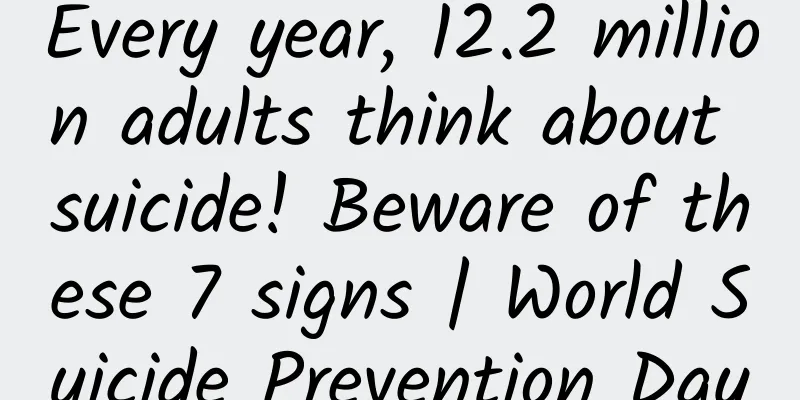Every year, 12.2 million adults think about suicide! Beware of these 7 signs | World Suicide Prevention Day

|
September 10, 2024 is the 22nd World Suicide Prevention Day , and this year’s theme is Changing the Narrative on Suicide and a Call to Action to Start a Conversation. The theme aims to raise awareness of the importance of reducing stigma and encouraging open dialogue to prevent suicide. According to statistics released by the World Health Organization (WHO) in 2021, the suicide rate in China was 7.5 per 100,000 people in 2019. According to data released in the "China Health Statistical Yearbook 2021", the suicide mortality rate among urban and rural residents in China was approximately 3.8 to 8.65 per 100,000 people. And this is just the proportion of people who commit suicide and die; the proportion of people who attempt suicide and simply have suicidal thoughts is much higher than this. For example, the annual statistical survey published by the US Centers for Disease Control and Prevention found that in 2020, a total of approximately 46,000 people died from suicide, while 1.2 million people attempted suicide, which is about 26 times the number of deaths from suicide, and 12.2 million adults reported having suicidal thoughts, which is approximately 10 times and 265 times the number of suicide attempts and deaths from suicide, respectively. These shocking figures make us wonder, can we identify people at risk of suicide, and how can we help them? Let’s talk about this in detail today. Suicide does have warning signs When tragedy strikes, many relatives and friends will feel that it is very sudden, but looking back afterwards, they can often find some clues. This is one of the characteristics of suicide - there are signs, but it is very sudden. If we can identify these signs, there is hope for intervention. Let's first look at a set of typical warning signs of suicide: (1) Depression: feeling helpless, desperate, hopeless, etc.; (2) Social isolation: becoming lonely and withdrawn, unwilling to communicate with family and friends, and unwilling to participate in social activities; (3) Behavioral changes: behavioral changes, such as sleep disorders, changes in appetite, personality changes, etc. (4) Loss of hobbies: For example, no longer paying attention to one’s hobbies, giving up one’s career, etc.; (5) Becoming frequently depressed and miserable: experiencing a state of emotional depression and misery that gradually increases day by day; (6) Violent tendencies: showing tendencies to self-harm or violence against oneself or others; (7) Claiming suicide: actively expressing suicidal thoughts or ideas online or in conversation; It’s important to note that while these signs do apply to some people, they are often not so accurate—people who have never thought about suicide may have these signs for other reasons, and even people who do think about suicide may not necessarily have these signs. Of course, considering the seriousness of the consequences of suicide, we still need to use it as a reference. When friends and relatives show such signs, we should also pay attention. After all, when it comes to issues involving life, misunderstandings are acceptable, but missing the signs and causing tragedy will leave regrets. Is suicide often just a matter of “a single thought”? Although suicide often comes as a surprise to relatives and friends, is suicide a deliberate act or an impulse? According to current research, although many people have suicidal thoughts for many years, when they actually carry it out, they mainly rely on "impulse". A psychological survey follow-up study that analyzed more than 80,000 people found that people who think about suicide almost every day have a 0.3% chance of dying by suicide in the next year, while those who have never thought about suicide have a 0.03% chance of dying by suicide in the next year. In other words, more than 99% of suicidal thoughts will not lead to death in the short term, and some people who commit suicide may never have thought about suicide before. An article published in Suicide and Life-Threatening Behavior studied 30 people who had recently attempted suicide and found that they generally went through the process of suicidal thoughts, conceiving a suicide plan, considering the location of suicide, making the final decision, and carrying out the suicide. Judging from the median time of these processes, suicidal thoughts and conceiving a plan generally occurred 1 to 5 years before the suicide behavior, while the conception of the current suicide behavior occurred 2 weeks ago, and the reconsideration of the previously conceived suicide location occurred 1 week ago. However, the actual decision was made 6 hours before suicide. They were still thinking about the method and location of suicide 2 hours before suicide. It took an average of 30 minutes to decide on the suicide location, and the final decision to commit suicide occurred 5 minutes before suicide. Figure | Steps and time of suicide, from Alexander er al., 2016 A 2017 study published in the Journal of Abnormal Psychology surveyed 54 adults who had attempted suicide in the previous year and 36 psychiatric patients who were hospitalized for suicide risk. The researchers conducted ecological momentary assessments (EMA) on them over a period of 10 to 28 days, using multiple assessment methods and an average of about 2.5 assessments per day to study changes in their suicidal ideation over the 2 to 4 weeks. The research results found that almost everyone's suicidal thoughts will fluctuate significantly every day, or even within 4 to 8 hours. Risk factors closely related to suicidal thoughts (such as despair, burden and loneliness) will also change greatly in just a few hours. Figure | Fluctuations in suicidal thoughts and risk factors, from Kleiman et al., 2017 This shows that many suicidal behaviors are just momentary impulses. They may have had the idea of suicide a long time ago and have not really thought about how to commit suicide. It is only because of some recent negative events that they have the urge to commit suicide. Researchers believe that before committing suicide, people often struggle with the idea of suicide and survival. If they have the idea of survival, they will return to the state of "low suicide risk". Once a person decides to commit suicide, they are likely to make a suicide plan and implement it within the next few hours. It may be because of this that suicide seems very sudden to relatives and friends. How to properly help someone with suicidal thoughts So how can we help people with suicidal thoughts? From a psychotherapy perspective, the most effective suicide prevention strategy is to enhance their ability to cope with external negative events. We can start with several effective strategies: 1. As the former Soviet educator Makarenko said: "If a person does not see a happy prospect when looking forward, he cannot survive in the world." Russian novelist Chekhov also wrote: "To survive, you must have something to rely on." When we find that someone has suicidal thoughts, we can try to discuss with him/her the reasons for living , such as family, friends, pets, and other favorite things, and have him/her write these reasons on a small card or make it into a mobile phone wallpaper so that he/she can always take it out and look at it, constantly reminding himself/herself that there is still hope in life. These reasons can also become his/her long-term psychological capital, thereby resisting the negativity and negativity in life. 2. Cognitive distortion therapy is often used in cognitive behavioral therapy to help correct negative thoughts and behaviors. People who want to commit suicide often have some wrong beliefs in their hearts, such as extreme thinking, generalization and catastrophic thinking. By guiding the other party to understand their wrong beliefs and using the record sheet method in daily life to record their negative thoughts and emotional intensity at the time , people can often realize that their thoughts are wrong in this process, thereby reducing the generation of negative emotions; 3. Practice mindfulness meditation in daily life. This is a purposeful, non-judgmental way to focus on the present moment. Through long-term mindfulness practice, people can learn to calm their minds, slow down their thinking and decision-making in moments of uncertainty or low mood, so as to make better decisions. At the same time, their ability to cope with negative events and emotions will also be improved. 4. Use safety planning intervention (SPI) to help the other person overcome difficulties. SPI is an effective method for alleviating suicide crises recognized by the American Suicide Prevention Best Practices Foundation and the Suicide Prevention Resource Center. It is a written list of priority response strategies and support sources . We use some cases to illustrate that everyone can formulate their own points to pay attention to and measures to take at each step according to their actual situation: Everyone deserves and can have a wonderful life. Although life can have many other flavors and the future is always full of uncertainty, we should all see these two sides and help others see the light on the other side and live bravely when others only see the darkness. Planning and production Author: Chen Yufeng, Master of Developmental and Educational Psychology Reviewer: Yang Xiaoyang, Associate Professor, School of Psychology, Sichuan Normal University Planning丨Ding Zong Editor: Ding Zong Proofread by Xu Lailinlin |
<<: Hiding atoms? This bold idea successfully breaks the record of atomic low temperature
Recommend
Why doesn't it rain diamonds on Earth?
Recently, a US scientific research team inferred ...
A quick overview of the history of computers
Part 01 introduction The history of computer deve...
Watch a short video every 3 minutes? Miaopai is just a game that inflates the number of views by 500 times
Miaopai is really brave On September 22, the cost...
The official TV version of "Three Kingdoms Heroes" is launched
Speaking of Three Kingdoms games, KT Pants-Taking...
Frankly speaking, it is inevitable that most information flow ads have poor conversion rates!
Recently, many optimizers and advertisers have as...
How much does it cost to customize the Yulin Book Mini Program? What is the price for customizing the Yulin Books mini program?
There are two types of customization of Yulin Boo...
Snowball Irish Thrush Stock Trading Training 2021 Course Video
Snowball Irish Thrush Stock Trading Training 2021...
Alipay launches a wave of new features: it is completely indispensable
[[283052]] On September 24, at the Alibaba Invest...
A complete guide to operating and promoting Tik Tok!
Do you know how to use Tik Tok, which has huge tr...
Deloitte Consulting: 2024 US Generative Artificial Intelligence Report
Deloitte has released its 'Generative AI in t...
Douyinmen·2022 Doudian no-source store group, the ultimate label 4.0 profit system is worth 999 yuan
Douyinmen·2022 Doudian no-source store group, the...
Decoding: How does Pinduoduo play with the addiction model?
Pinduoduo has a variety of promotion methods, whi...
10 common problems in Kuaishou short video operation, must-read for beginners
The rapid development of the Internet has also le...
Common content misunderstandings of low-follow Douyin sales accounts
Recently, many friends have been asking questions...









